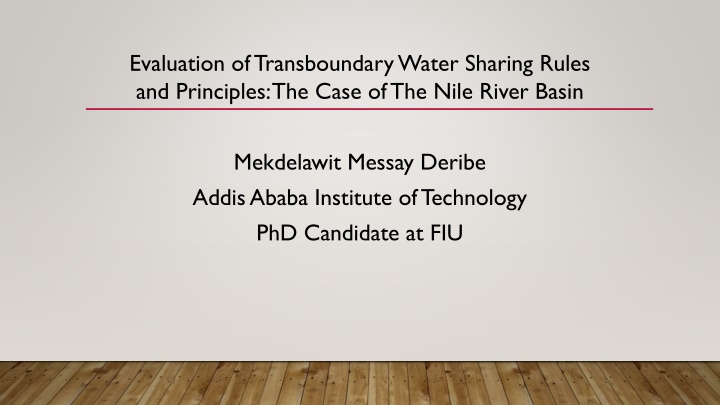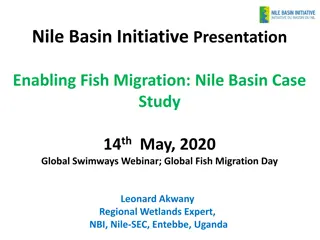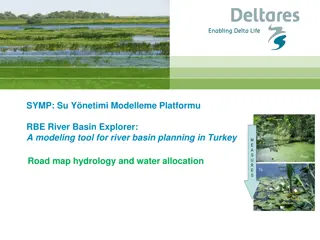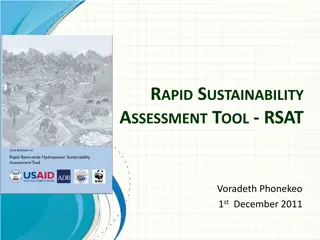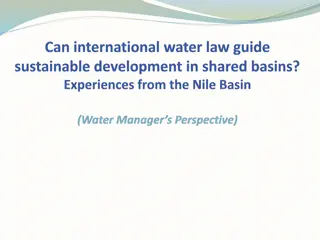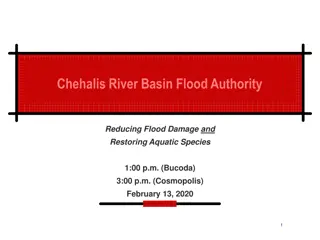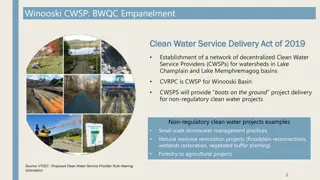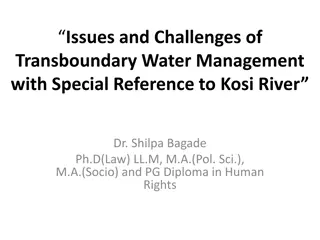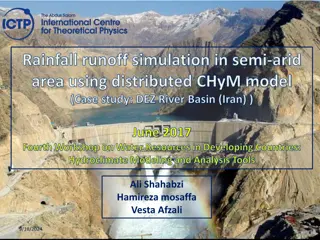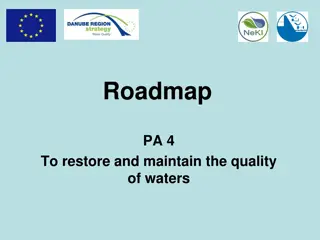Evaluation of Transboundary Water Sharing Rules: The Nile River Basin Case
This study examines the complex nature of transboundary water management, focusing on the Nile River Basin. It addresses issues such as water scarcity, population growth, and climate change affecting water resources. The research aims to evaluate existing water sharing principles, identify challenges in implementation, and propose a framework for equitable water allocation in the basin.
Download Presentation

Please find below an Image/Link to download the presentation.
The content on the website is provided AS IS for your information and personal use only. It may not be sold, licensed, or shared on other websites without obtaining consent from the author.If you encounter any issues during the download, it is possible that the publisher has removed the file from their server.
You are allowed to download the files provided on this website for personal or commercial use, subject to the condition that they are used lawfully. All files are the property of their respective owners.
The content on the website is provided AS IS for your information and personal use only. It may not be sold, licensed, or shared on other websites without obtaining consent from the author.
E N D
Presentation Transcript
Evaluation of Transboundary Water Sharing Rules and Principles: The Case of The Nile River Basin Mekdelawit Messay Deribe Addis Ababa Institute of Technology PhD Candidate at FIU
BACKGROUND Water scarcity Population growth Climate change Transboundary waters: 80% of world s fresh water 2/3 of transboundary river basins do not have a cooperative framework,
RATIONALE/ PROBLEM STATEMENT Transboundary water management difficult because: Countries needs asymmetric Claims more than endowments Different interpretation of water sharing principles Very general legal principles, Need for contextualization and quantification
RESEARCH OBJECTIVE Contextualize and quantitively evaluate widely used transboundary water sharing principles on the Nile basin to come up with the basis for a reasonable and equitable water allocation framework
EVOLUTION OF TRANSBOUNDARY WATER SHARING PRINCIPLES MeslilimTreaty Navigational rules Absolute territorial sovereignty/ Harmon Doctrine Absolute territorial integrity Prior appropriation Limited territorial sovereignty Community of interest
FACTORS FOR EQUITABLE UTILIZATION Factors Helsinkin 1966 F1 Geography F2 Hydrology F3 Climate F4 Past utilization F5 Economic and social needs F6 Dependent Population F7 cost of Alternative means Availability of other resources F9 Avoidance of waste F10 Compensation F11 Degree of not causing harm UN 1997 Physical factors Socio economic needs Dependent Population Effect of use on others Existing and potential use cost of Conservation Alternative resources CFA Physical factors Socio economic needs Dependent Population Effect of use on others Existing and potential use cost of Conservation Alternative resources F8 Contribution to water Extent of drainage area
INTERNATIONAL WATER SHARING FACTORS F1: Geography of the basin F6: Economic and social needs F2: Hydrology of the basin F7: Alternative resources F3: Climate affecting the basin F8: Effect of use on other basin states F 4: Population dependent on the basin F9: Avoidance of unnecessary waste F5: Existing use
Quantification summary F1 F2 F F F F F5 F6 F F 7.2 F8 F9 (%) (%) 3.1 3.2 4.1 4.2 (%) 7.1 (%) (%) (%) Country (%) (%) (%) (%) (%) (%) Burundi 0.44 4.06 13.36 6.87 2.30 2.60 0.05 0.05 0.03 0 0.02 0.1 DRC 0.69 4.33 13.01 7.1 1.17 32.07 0.01 0.02 20.79 0.49 0 - Egypt 9.52 0 0.45 12.42 34.55 2.69 79.07 57.9 29.96 32.52 58.47 11.95 Eritrea 0.81 - 3.41 11.09 0.89 1.42 - - 6.89 0 0 - Ethiopia 11.5 83.3 11.49 8.65 15.14 29.21 1.83 15.57 0.18 29.65 16.93 31.32 Kenya 1.62 7.06 8.1 9.98 6.93 12.19 1.67 3.35 4.8 7.11 1.15 1.37 Rwanda 0.65 4.98 11.32 5.99 3.50 0.85 0.28 0.41 0.03 0 0.07 0.14 South 19.54 8.86 11.21 9.09 4.79 0.05 0.11 3.27 17.15 0 3.38 18.5 Sudan Sudan 43.95 5.88 3.01 12.64 12.65 2.22 16.35 17.92 17.15 11.32 18.96 35.25 Tanzania 3.73 4.7 10.82 7.76 4.55 15.88 0.09 0.75 2.85 18.9 0.79 1.05 Uganda 7.56 4.6 13.84 8.43 13.53 0.19 0.54 0.75 0.18 0 0.24 0.33
SCENARIOS Scenario 1: Equal weights Scenario 2: Restricted Country Optimization Scenario 3: Basin sum maximization
SCENARIO 2: RESTRICTED OPTIMIZATION 70% Scenarion2 vs Current use 60% 50% Scenario 2 Current state 40% 30% 20% 10% 0% -10% South Sudan 23% 0% Tanzani a 9% 0% Egypt Sudan Ethiopia Eritrea Kenya Rwanda Uganda Burundi Congo Scenario 2 Current state 55% 66% 43% 22% 60% 0% -1% 0% 10% 0% 6% 0% 12% 0% 5% 0% 11% 0%
SCENARIO 3: BASIN SUM OPTIMIZATION 3%2%4%2% Sudan Ethiopia Eritrea South Sudan Kenya Tanzania Rwanda Uganda Burundi Congo 3% Egypt 4% 29% 8% 0% 26% 20%
SCENARIO ENVELOPE Scenario Envelope Scenario 2 Scenario 1 Scenario 3 Current state 70.00% 60.00% 50.00% 40.00% 30.00% 20.00% 10.00% 0.00% Egypt Sudan Ethiopia Eritrea South Sudan Kenya Tanzania Rwanda Uganda Burundi Congo -10.00%
CONCLUSION Existing water allocation has no basis under modern water sharing laws Current dominant water users will get lower shares under equitable allocations Need to go beyond water allocation to accommodate water demands of all countries
RECOMMENDATION Physical water trade Virtual water trade Increased Efficiency Water Smart Investments Regional integration for synchronized planning and operation Benefit sharing and co-owned projects Exploring alternative water resources Environmental Conservation and creating water conscious
